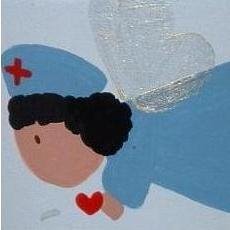41. A nurse is observing a child’s motor, sensory and speech development. The child is 7 months old. Which of the following tasks would generally not be observed?
A: Child recognizes tone of voice.
B: Child exhibits fear of strangers.
C: Child pulls to stand and occasionally bounces.
D: Child plays patty-cake and imitates.
42. A nurse is observing a child’s motor, sensory and speech development. The child is 5 months old. Which of the following tasks would generally not be observed?
A: Child sits with support.
B: Child laughs out loud.
C: Child shifts weight side to side in prone.
D: Child transfers objects between hands.
43. A nurse is caring for an adult that has recently been diagnosed with renal failure. Which of the following clinical signs would most likely not be present?
A: Hypotension
B: Heart failure
C: Dizziness
D: Memory loss
44. A nurse is caring for an adult that has recently been diagnosed with hypokalemia. Which of the following clinical signs would most likely not be present?
A: Leg cramps
B: Respiratory distress
C: Confusion
D: Flaccid paralysis
45. A nurse is caring for an adult that has recently been diagnosed with metabolic acidosis. Which of the following clinical signs would most likely not be present?
A: Weakness
B: Dysrhythmias
C: Dry skin
D: Malaise
46. A nurse is caring for an adult that has recently been diagnosed with metabolic alkalosis. Which of the following clinical signs would most likely not be present?
A: Vomiting
B: Diarrhea
C: Agitation
D: Hyperventilation
47. A nurse is caring for an adult that has recently been diagnosed with respiratory acidosis. Which of the following clinical signs would most likely not be present?
A: CO2 Retention
B: Dyspnea
C: Headaches
D: Tachypnea
48. A nurse is caring for an adult that has recently been diagnosed with respiratory alkalosis. Which of the following clinical signs would most likely not be present?
A: Anxiety attacks
B: Dizziness
C: Hyperventilation cyanosis
D: Blurred vision
49. A nurse is reviewing a patient’s medication list. The drug Pentoxifylline is present on the list. Which of the following conditions is commonly treated with this medication?
A: COPD B: CAD
C: PVD
D: MS
50. A patient has been on long-term management for CHF. Which of the following drugs is considered a loop dieuretic that could be used to treat CHF symptoms?
A: Ciprofloxacin
B: Lepirudin
C: Naproxen
D: Bumex
51. A patient has recently been diagnosed with polio and has questions about the diagnosis. Which of the following systems is most affected by polio?
A: PNS
B: CNS
C: Urinary system
D: Cardiac system
52. A nurse is educating a patient about right-sided heart deficits. Which of the following clinical signs is not associated with right-sided heart deficits?
A: Orthopnea
B: Dependent edema
C: Ascites
D: Nocturia
53. A nurse is reviewing a patient’s medication. Which of the following is considered a potassium sparing dieuretic?
A: Esidrix
B: Lasix
C: Aldactone
D: Edecrin
54. A nurse is reviewing a patient’s medication. The patient is taking Digoxin. Which of the following is not an effect of Digoxin?
A: Depressed HR
B: Increased CO
C: Increased venous pressure
D: Increased contractility of cardiac muscle
55. A patient has been instructed by the doctor to reduce their intake of Potassium. Which types of foods should not worry about avoiding?
A: Bananas
B: Tomatoes
C:
D: Apples
56. A patient’s chart indicates the patient is suffering from Digoxin toxicity. Which of the following clinical signs is not associated with digoxin toxicity?
A: Ventricular bigeminy
B: Anorexia
C:
D: Nausea
57. A fourteen year old male has just been admitted to your floor. He has a history of central abdominal pain that has moved to the right iliac fossa region. He also has tenderness over the region and a fever. Which of the following would you most likely suspect?
A: Appendicitis
B: Acute pancreatitis
C: Ulcerative colitis
D: Cholecystitis
58. A thirteen-year old male has a tender lump area in his left groin. His abdomen is distended and he has been vomiting for the past 24 hours. Which of the following would you most like suspect?
A: Ulcerative colitis
B: Biliary colic
C: Acute gastroenteritis
D: Strangulated hernia
59. Which of the following is the key risk factor for development of Parkinson’s disease dementia?
A: History of strokes
B: Acute headaches history
C: Edward’s syndrome
D: Use of phenothiazines
60. A father notifies your clinic that his son’s homeroom teacher has just been diagnosed with meningitis and his son spent the day with the teacher in detention yesterday. Which of the following would be the most likely innervention?
A: Isolation of the son
B: Treatment of the son with Aciclovir
C: Treatment of the son with Rifampicin
D: Reassure the father
61. A patient has recently been diagnosed with hyponatremia. Which of the following is not associated with hyponatremia?
A: Muscle twitching
B: Anxiety
C: Cyanosis
D: Sticky mucous membranes
62. A patient has recently been diagnosed with hypernatremia. Which of the following is not associated with hypernatremia?
A: Hypotension
B: Tachycardia
C: Pitting edema
D: Weight gain
63. Which of the following normal blood therapeutic concentrations is abnormal?
A: Phenobarbital 10-40 mcg/ml
B: Lithium .6 – 1.2 mEq/L
C: Digoxin .5 – 1.6 ng/ml
D: Valproic acid 40 – 100 mcg/ml
64. Which of the following normal blood therapeutic concentrations is abnormal?
A: Digitoxin 09 – 25 mcg/ml
B: Vancomycin 05 – 15 mcg/ml
C: Primidone 02 – 14 mcg/ml
D: Theophylline 10 – 20 mcg/ml
65. Which of the following normal blood therapeutic concentrations is abnormal?
A: Phenytoin 10 – 20 mcg/ml
B: Quinidine 02 – 06 mcg/ml
C: Haloperidol 05 – 20 ng/ml
D: Carbamazepine 5 – 25 mcg/ml










0 comments:
Post a Comment